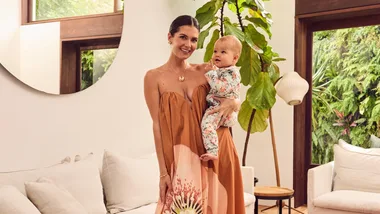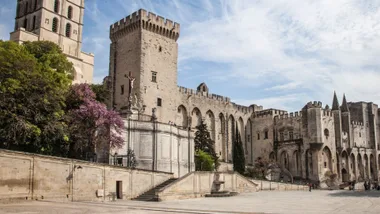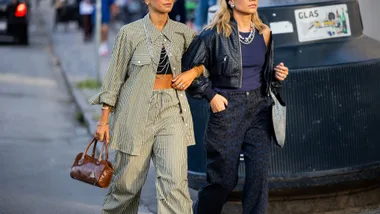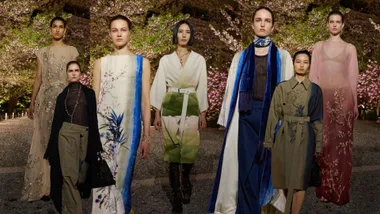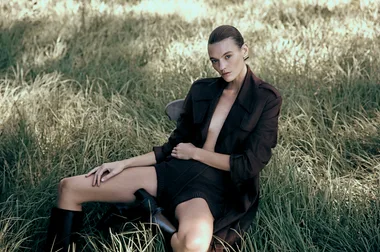After an absence last year and a rebrand, Afterpay Australian Fashion Week returned for 2021 with gusto, showcasing veteran design talent and new names working at the cutting edge in their respective cutting rooms.
Gratifying to see among the lineup was an official Welcome to Country, two showcases of Indigenous fashion designers, and what turned out to be the most progressive, joyous show of the week from multidisciplinary designer Jordan Gogos.
Within the shows themselves, gender-restrictive styling was dispensed of. Male models walked the runway in gowns at Romance Was Born and the exuberant Gogos show highlighted the eminent ballroom performers of House of Silky, the first time such a group has walked together on an Australian runway. A number of drag performers including Etcetera Etcetera and Indigenous drag artist Felicia Foxx appeared on runways—unbelievably looking even more fabulous than usual.
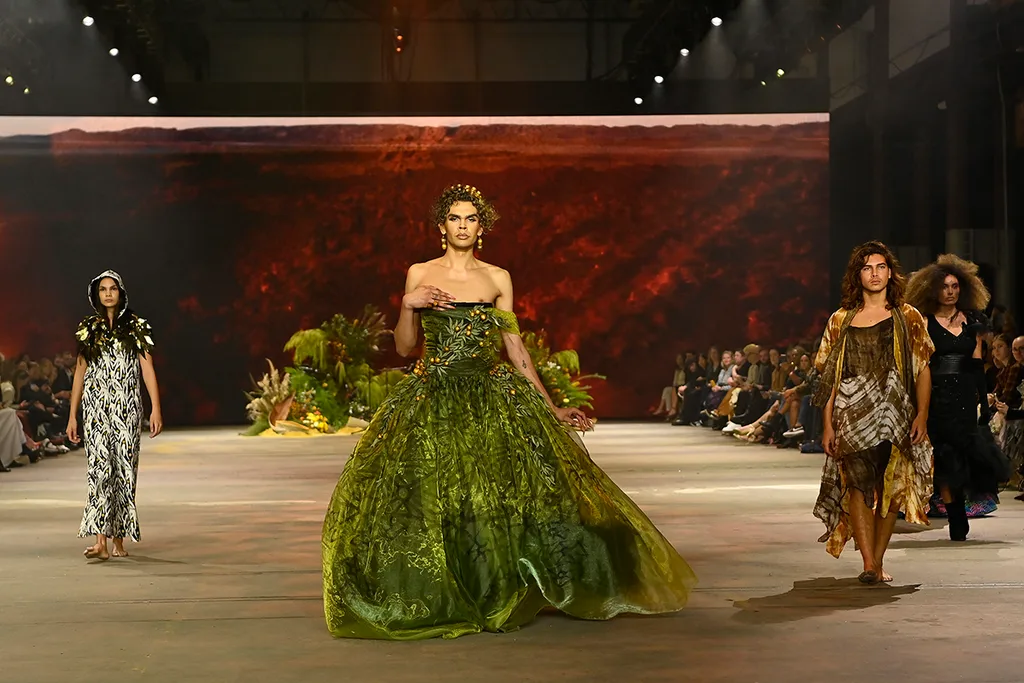
One show that gave us particular pause? The Indigenous Fashion Projects show. It was the second long-overdue showcasing of Indigenous designers that occurred during 2021’s Australian Fashion Week. The show auspiciously took place on June third, Mabo Day, which commemorates land rights activist and Torres Strait Islander man Eddie Koiki Mabo and his work to overturn the legal concept of “terra nullius”—that Australia was an unoccupied void prior to the arrival of white convicts.
Aunty Ann Weldon from the Metropolitan Local Aboriginal Land Council opened the show with an acknowledgement of country. Given the ongoing discussions and focus around sustainability and adaptability within the fashion world, it was incredibly gratifying to hear her voice the facts: that there is no better example than Australia’s traditional and rightful owners when it comes to enduring and adapting.
Though it goes without saying there is a copious amount that Western cultures have to learn from the way Indigenous cultures interface with our environment—start with professor Robin Wall Kimmerer’s book Braiding Sweetgrass—the six Indigenous designers who featured in the IFP show actually received mentoring from several established Australian designers.

Seeing dot painting style prints, in particular, come down the runway, one can’t help but consider the different ways that art and its recognisability are taken up by the fashion world. While there were any number of watercolour-esque prints in other Australian Fashion Week shows and trendy pieces like landscape knits from House of Sunny and check print pants from Holiday the Label saturate our feeds, it’s hard to think of any Indigenous motifs that have been taken up with the same vigour.

What stops one of the most unique, immediately identifiable styles of art from being taken up the way Van Gogh’s sunflowers or Monet’s water lilies are? Or established white Australian designers tapping Indigenous artists to collaborate and design prints beyond select ‘special edition’ collections?
There’s absolutely no denying that seeing Indigenous designers platformed in this way at Australian Fashion Week is gratifying and moving. However, every single person I spoke to or interviewed during Fashion Week expressed a desire for more true, authentic diversity. That extends to model castings, speakers, designers who are afforded shows—and that these efforts actually appear in the week’s prime time slots to reach an audience beyond the people who are already in attendance. (And likely are already engaging with inclusivity on some level.)
The topic of “representation” feels particularly fraught in these industries—mainstream media always has an opportunity to better itself too—and unfortunately, many conversations around it feel quite surface. In the days since models, photographers, stylists and editors have recuperated from the intense week, a concurrent thread is emerging. Namely, that while decent first steps have been made towards more diverse representation, Australian Fashion Week has a very long journey ahead to true inclusivity.
Model and House of Silky artist Basjia Almaan, who walked multiple shows during Australian Fashion Week, took to Instagram to speak about her experience. “Whilst I’m incredibly proud of how hard I had to work to be on that runway stage, I’m pretty disappointed at how much of a process it was for space to be made for someone like myself,” she wrote.
Almaan reported needing to wear braids to book shows and an awareness that being curvy but “still palatable,” afforded models more opportunities—other models I spoke to believed having lighter skin or ethnically ambiguous looks similarly aided them. “This show was not diverse, it was tokenistic,” she wrote of the multi-designer closing show, titled the Future of Fashion. “Even though it was wonderful to see a range of models of different ethnicities and colour, models of different ages and curve models, it was all still so palatable.”
Going beyond just appearances—as it were—9Honey’s Shelly Horton spoke with Leina Broughton, the creative director of inclusively sized brand Leina & Fleur, which caters to a size 8-24. Per Broughton’s digging, many of the labels which debuted collections only catered up to a size 14, with many actual measurements skewing smaller anyway.
“I went through the list of labels that were there [at AAFW] and checked to be really clear. In all of the 70 labels in Fashion Week only four labels offered a size 18,” Broughton shared. Curve models like Mahalia Handley and Kate Wasley also pointed out the deficit of truly inclusive size ranges. In response to retailers who would claim that plus-sized customers don’t shop in their stores, Wasley pointed out the simple explanation: “We don’t feel welcome.”
Then there’s the gut-wrenching video of a model and Paralympian, Rheed McCraken, appearing in the Future of Fashion show. In a video posted on TikTok by @theexampleau, McCraken is seen using a wheelchair, struggling to move across a runway festooned with decorations that are getting caught in or blocking his chair.
Another model in a wheelchair had difficulty moving across the runway during the same show, with designer Camilla Franks of Camilla coming to her aid. The difference between tokenistic representation and true, authentic inclusivity couldn’t be clearer.
Speaking to Jasmine Wallis for Fashion Journal, disabled online creator and activist Keely B reflected frankly about the uncomfortable and disappointing misstep, “It isn’t inclusive if it isn’t accessible for disabled people. I don’t want to see disabled people struggle to use their mobility aids, that isn’t representation of disabled people.”
“If [Australian Fashion Week] can’t even make a runway accessible, it’s scary to think about the wider inclusion in this industry. It really just shows that there isn’t any,” she said.
The moment embodies the consequences of the lack of consideration and consultation of disabled people and the exhausting cycle of “representation” discourse. In an event so tied to visual spectacle, how does one differentiate between tokenisation and actually inclusive, considered gestures made in good faith?
And it’s not as though there aren’t good examples of Australian designers choosing to stand by the people they employ and affiliate with to lend their brands the cultural capital and relevancy that is so often associated with those at the margins. Acler’s recent response to the bigotry they encountered when sharing a picture of the non-binary stylist Deni Todorović in one of their designs comes to mind.
“We use this platform to share images of our friends and customers wearing our collections, and yesterday that post featured Deni, an Australian stylist, activist, and educator who identifies as non-binary and who uses the pronouns, ‘they/them’,” wrote the brand in an Instagram post. The South Australian label explained they were deeply saddened by the hateful comments the post received, stating that they were taking a zero-tolerance policy towards any bullying and noting: “We design our collections for all who chose to wear them.”
(For what it’s worth, Acler, while commendably standing by Todorović, aren’t themselves an inclusively-sized brand. A peruse of their site returns only a few styles offered in an Australian size 14, at the largest.)
Generally, ‘calling in’ feels kinder and more effective than ‘calling out.’ However, is it worth considering that in encouraging marginalised people to enter and ascend within structures that are still proving themselves to be deeply exclusionary, an opportunity to make something entirely new—beyond the conventions and confines of this event—is being missed?
Though that answer remains uncertain, beautiful, innovative and culturally enriched work is happening regardless. And if it remains in a space outside of Australian Fashion Week? It will be the industry’s loss.

